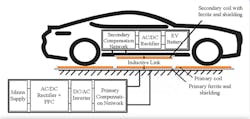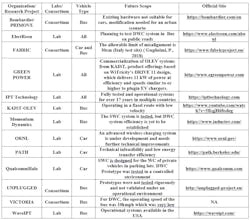The Escalating Deployment of Dynamic Wireless Power Transfer EV Charging
Electrification is a critical part of reducing energy-related CO2 emissions, but electric vehicle (EV) users are often frustrated by the limited range of EVs, slow charging, and limited charging facilities available along their route. These factors contribute to a slow uptake of electrification. Based on our recent study at the University of Auckland, Wireless Power Transfer (WPT) technology, both dynamic wireless charging (DWC) and stationary wireless charging (SWC) will play a major role in electrification going forward. The escalating deployment of DWC, otherwise called dynamic wireless power transfer (DWPT) is our focus.
Case in point, when the new 1.5-billion-dollar, Kansas City International Airport (KCI) opens in February, the state-of-the-art complex will feature the first-of-its-kind, EV wireless charging system without an above-ground charging station and no need to take buses out of service for charging.
Inductive charging will extend the range of the electric buses without the above-ground charging station. It was the only system the design team found that can deliver energy without the traditional plug-in infrastructure.
One of the first pilot tests of an IPT charging system was carried out in late 1980 by California Partners for Advanced Transit and Highways. Closer to home our research team reviewed the first pilot project to commercialize an IPT system, which was carried out in the mid-1990s at our university in Auckland, New Zealand (US patent 5 293 308A). It was subsequently developed in the Daifuku monorail systems for vehicle assembly plants and clean factory automation by John T. Boys and Andrew W. Green. In 1998, the first commercial IPT system was also successfully tested for EV movement (DWC) at Rotorua Thermal Park in New Zealand. This was followed by commercial bus charging developments in association with Conductix-Wampfler in Europe and USA.
In Kansas City
The new 10,000-acre complex was designed to include a first-of-kind, wireless charging system for the busses. Charging pads, 4-foot square, have been embedded in the pavement to charge the buses at the passenger load-unload zones and the bus garage. Pads at both ends of the 7-mile bus route were developed by Momentum Dynamics Corporation in Malvern, Pennsylvania. The pads are positioned to send a charge magnetically, a few minutes at a time, across an eight-inch air gap from the pad to a plate on the underside of the EV buses.
Other Wireless Players
Since the inception of WPT technology in the 1980s, several organizations or research groups have been working on the development of wireless charging models for EVs.
Ramesh Chandra Majhi is a PhD candidate in the department of Civil and Environmental Engineering, at the University of Auckland, Auckland, New Zealand. Ramesh’s current research focuses on designing the optimization modeling framework and conducting an economic evaluation for the Inductive Power Transfer roadway systems in New Zealand. His PhD work is supported by the MBIE, New Zealand grant and he has already published five research articles in the field of traffic and transportation planning.
Dr. Prakash Ranjitkar is a Senior Lecturer in the Department of Civil and Environmental Engineering at the University of Auckland. He has more than 20 years of experience in a range of transport and other infrastructure projects as an academician, researcher, and consultant. Prakash’s research interests are in the modeling and simulation of transport facilities, intelligent transportation systems, traffic operations, traffic safety, public transport, and applications of emerging technologies in transportation.
Dr. Selena Sheng holds a PhD in Economics from the University of Auckland. She comes with expertise in applied economics/econometrics, and advanced data analysis, especially in the field of transport economics. Her current research focuses on intelligent transport systems, road safety issues, and spatial econometrics.
About the Author
Ramesh Chandra Majhi
Ramesh Chandra Majhi is a PhD candidate in the department of Civil and Environmental Engineering, at the University of Auckland, Auckland, New Zealand. Ramesh’s current research focuses on designing the optimization modeling framework and conducting an economic evaluation for the Inductive Power Transfer roadway systems in New Zealand. His PhD work is supported by the MBIE, New Zealand grant and he has already published five research articles in the field of traffic and transportation planning.
Prakash Ranjitkar
Dr. Prakash Ranjitkar is a Senior Lecturer in the Department of Civil and Environmental Engineering at the University of Auckland. He has more than 20 years of experience in a range of transport and other infrastructure projects as an academician, researcher, and consultant. Prakash’s research interests are in the modeling and simulation of transport facilities, intelligent transportation systems, traffic operations, traffic safety, public transport, and applications of emerging technologies in transportation.
Selena Sheng
Dr. Selena Sheng holds a PhD in Economics from the University of Auckland. She comes with expertise in applied economics/econometrics, and advanced data analysis, especially in the field of transport economics. Her current research focuses on intelligent transport systems, road safety issues, and spatial econometrics.




